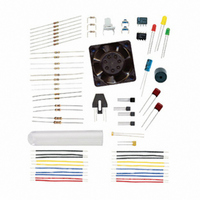130-28176 Parallax Inc, 130-28176 Datasheet - Page 228

130-28176
Manufacturer Part Number
130-28176
Description
KIT PARTS PROCESS CONTROL
Manufacturer
Parallax Inc
Specifications of 130-28176
Accessory Type
Education Kit
Product
Microcontroller Accessories
Lead Free Status / RoHS Status
Contains lead / RoHS non-compliant
For Use With/related Products
Board of Education Full Kit
Lead Free Status / RoHS Status
Lead free / RoHS Compliant, Contains lead / RoHS non-compliant
- Current page: 228 of 330
- Download datasheet (11Mb)
Page 218 · Process Control
CONCLUSION
The ability to measure temperature, or other analog parameters, is dependent on the
resolution of the system. Using the ADC0831, an 8-bit analog-to-digital converter, a
span of voltages from 0 to 5 V can only be resolved to 255 steps. To increase the
resolution, the incoming signal may be amplified and offset to narrow in on the range of
voltages of interest. The ADC0831 has built in features to set the span and offset using
its Vin(-), Vin(+) and Vref pins. By setting the voltages on these pins, the ADC can be
configured to convert a defined range to byte values of 0 to 255. Using filtered PWM,
the BASIC Stamp can be programmed to automatically set these pins and adjust the range
of conversion for the ADC0831. Combining this device with the LM34 temperature
sensor, which has an output of 0.01V/°F, systems temperatures can be monitored to a
high degree of resolution.
Another means to increase the resolution would be to use an ADC with higher resolution,
such as 12-bit ADC. This type of ADC resolves a range of temperatures to 4095 steps
12
(2
− 1). Over the range of 0 to 500 °F (0 to 5 V), this would provide a resolution of
0.122 °F. Another popular style of ADC converts the analog voltage to 10-bits for a
range of 0 to 1023.
PWM can also be used to control the power supplied to the control element, a resistive
heater in these experiments. Using PWM, the transistor is cycled on quickly, effectively
controlling the power supplied to the heater. Recall from Chapter 5 that the filtered
PWM may also be used to control the voltage to the element, but the transistor will be
controlled in the linear region, causing it dissipate large amounts of power, causing it to
heat.
By adjusting the power to the heater, a value of PWM can be found that will control the
temperature in the band at or near the setpoint. A drawback to this manual control is that
as conditions change, the setting may no longer be appropriate for control at the setpoint.
In the next chapter, we will study control scenarios to automatically control a system at
the setpoint.
Related parts for 130-28176
Image
Part Number
Description
Manufacturer
Datasheet
Request
R

Part Number:
Description:
KIT PROPELLER EDU PROJECT PARTS
Manufacturer:
Parallax Inc
Datasheet:

Part Number:
Description:
KIT PARTS SMART SENSORS
Manufacturer:
Parallax Inc
Datasheet:

Part Number:
Description:
Microcontroller Modules & Accessories DISCONTINUED BY PARALLAX
Manufacturer:
Parallax Inc

Part Number:
Description:
BOOK UNDERSTANDING SIGNALS
Manufacturer:
Parallax Inc
Datasheet:

Part Number:
Description:
COMPETITION RING FOR SUMOBOT
Manufacturer:
Parallax Inc
Datasheet:

Part Number:
Description:
TEXT INFRARED REMOTE FOR BOE-BOT
Manufacturer:
Parallax Inc
Datasheet:

Part Number:
Description:
Microcontroller Modules & Accessories DISCONTINUED BY PARALLAX
Manufacturer:
Parallax Inc

Part Number:
Description:
BOOK UNDERSTANDING SIGNALS
Manufacturer:
Parallax Inc
Datasheet:

Part Number:
Description:
BOARD EXPERIMENT+LCD NX-1000
Manufacturer:
Parallax Inc
Datasheet:

Part Number:
Description:
IC MCU 2K FLASH 50MHZ SO-18
Manufacturer:
Parallax Inc
Datasheet:













